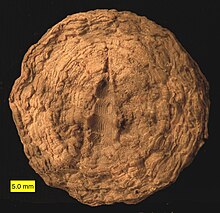|
Pleurodictyum
Pleurodictyum is an extinct genus of tabulate corals, characterized by polygonal corallites.[1] Colonies commonly encrust hard substrates such as rocks, shells and carbonate hardgrounds.[2] DistributionFossils of Pleurodictyum have been found in:[3]
Argentina, Australia, Bolivia, Tajikistan, and the United States (Kentucky, Wisconsin)
Algeria, Australia, Bolivia, Brazil, Canada (Ontario), China, Colombia (Floresta Formation, Altiplano Cundiboyacense), the Czech Republic, France, Germany, Luxembourg, New Zealand, South Africa, Spain, Tajikistan, Turkey, the United Kingdom, United States (Indiana, Kentucky, Michigan, New York, Ohio, Pennsylvania, Tennessee), and Venezuela
Czech Republic, Mexico, and the United States (Georgia) References
|
||||||||||||||||||||||||||||||

